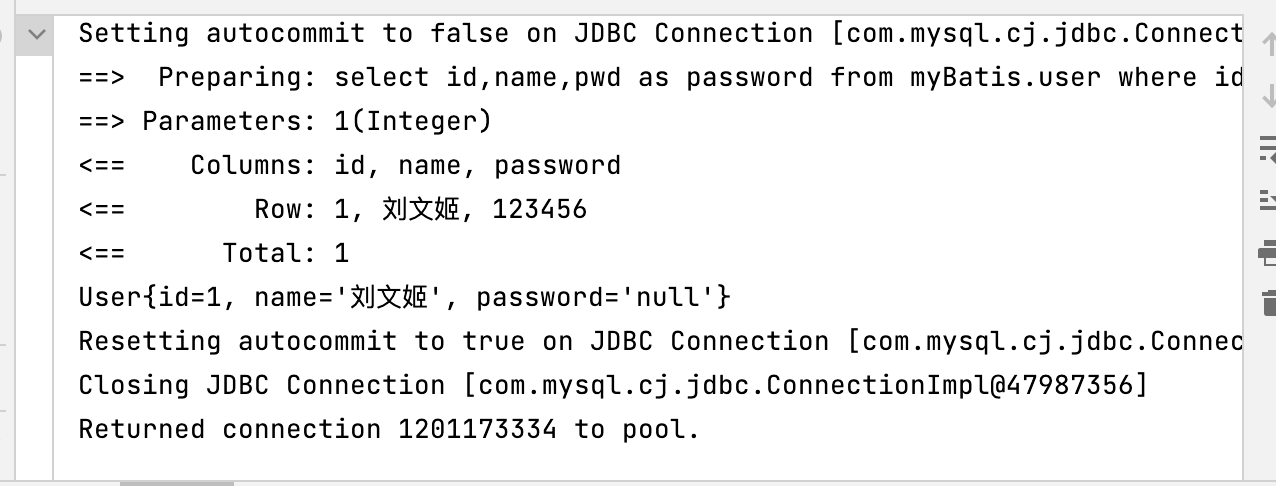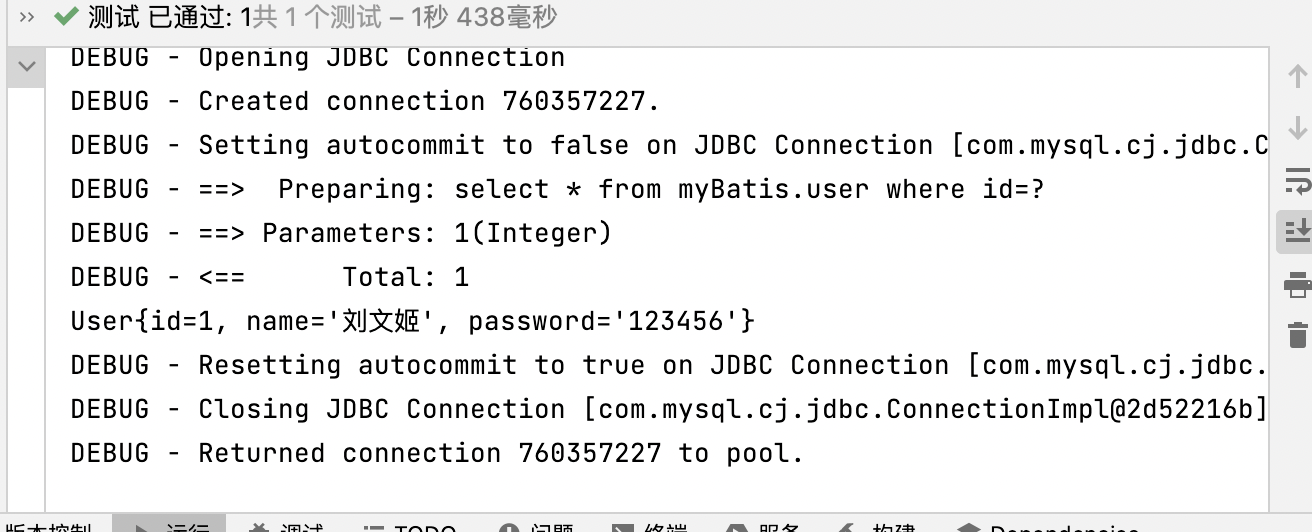Day18-MyBatis
-
如何获得Mybatis?
-
maven仓库:
<!-- https://mvnrepository.com/artifact/org.mybatis/mybatis -->
<dependency>
<groupId>org.mybatis</groupId>
<artifactId>mybatis</artifactId>
<version>3.5.13</version>
</dependency>
-
Github官网:https://github.com/
-
mybatis中文文档:https://mybatis.org/mybatis-3/zh/getting-started.html
-
持久化
-
持久化就是将程序的数据在持久状态和瞬时状态转化的过程
-
内存:断电及失
-
数据库(jdbc),io文件持久化
为什么需要持久化?
-
有一些对象不能让他丢掉
-
内存太贵
持久层
Dao层,service层,Controller层
-
完成持久化工作的代码块
-
层界限十分明显
为什么需要Mybatis?
-
方便
-
传统的jdbc代码太复杂了,简化,框架,自动化
-
帮助程序员将数据存入到数据库中
-
优点:
-
简单易学
-
灵活
-
sql和代码的分离,提高了可维护性
-
提供映射标签,支持对象与数据库的orm字段关系映射
-
提供对象关系映射标签,支持对象关系组建维护
-
提供xml标签,支持编写动态sql
-
第一个Mybatis程序
1.1 搭建环境
搭建数据库
CREATE DATABASE `mybatis`;
USE `mybatis`;
CREATE TABLE `user`(
`id` int(20) NOT NULL,
`name` VARCHAR(30) DEFAULT NULL,
`pwd` VARCHAR(30) DEFAULT NULL,
PRIMARY KEY(id)
)ENGINE=INNODB DEFAULT CHARSET=utf8;
insert INTO `user`(`id`,`name`,`pwd`) VALUES
(1,'文姬','123456'),
(2,'小绿','123456'),
(3,'月月','123456'),
(4,'小玉','123456')
新建项目
-
新建一个普通的maven项目
-
删除src目录
-
导入maven依赖
1.2创建一个模块
-
编写mybatis的核心配置文件
-
编写mybatis工具类
package com.lsq.utils;
import org.apache.ibatis.io.Resources;
import org.apache.ibatis.session.SqlSession;
import org.apache.ibatis.session.SqlSessionFactory;
import org.apache.ibatis.session.SqlSessionFactoryBuilder;
import javax.swing.plaf.synth.SynthToolTipUI;
import java.io.IOException;
import java.io.InputStream;
/**
* @author liushaoqin
* @version 1.0
* @sqlSessionFactory sqlSession
*/
public class MybatisUtils {
private static SqlSessionFactory sqlSessionFactory;
static{
try {
//使用Mybatis第一步:获取sqlSessionFactory对象
String resource="mybatis-config.xml";
InputStream inputStream = null;
inputStream = Resources.getResourceAsStream(resource);
sqlSessionFactory = new SqlSessionFactoryBuilder().build(inputStream);
} catch (IOException e) {
throw new RuntimeException(e);
}
}
//既然有了 SqlSessionFactory,顾名思义,我们可以从中获得 SqlSession 的实例。SqlSession 提供了在数据库执行 SQL 命令所需的所有方法。你可以通过 SqlSession 实例来直接执行已映射的 SQL 语句
public static SqlSession getSqlSession(){
return sqlSessionFactory.openSession();
}
}
1.3 编写代码
-
实体类
package com.lsq.pojo;
/**
* @author liushaoqin
* @version 1.0
*/
public class User {
private int id;
private String name;
private String pwd;
public User() {
}
public User(int id, String name, String pwd) {
this.id = id;
this.name = name;
this.pwd = pwd;
}
public int getId() {
return id;
}
public void setId(int id) {
this.id = id;
}
public String getName() {
return name;
}
public void setName(String name) {
this.name = name;
}
public String getPwd() {
return pwd;
}
public void setPwd(String pwd) {
this.pwd = pwd;
}
-
Dao接口
package com.lsq.dao;
import com.lsq.pojo.User;
import java.util.List;
/**
* @author liushaoqin
* @version 1.0
*/
public interface UserDao {
List<User> getUserList();
} -
接口实现类由原来的UserDaoImpl转换为Mapper配置文件
<?xml version="1.0" encoding="UTF-8" ?>
<!DOCTYPE mapper
PUBLIC "-//mybatis.org//DTD Mapper 3.0//EN"
"https://mybatis.org/dtd/mybatis-3-mapper.dtd">
<!--namespace绑定一个Dao/Mapper接口-->
<mapper namespace="com.lsq.dao.UserDao">
<!--select查询语句-->
<select id="getUserList" resultType="com.lsq.pojo.User">
select * from myBatis.user where id = #{id}
</select>
</mapper>
1.4 测试
注意点:
org.apache.ibatis.binding.BindingException: Type interface com.lsq.dao.UserDao is not known to the MapperRegistry.
核心配置文件中注册mappers
-
junit
package com.lsq.dao;
import com.lsq.pojo.User;
import com.lsq.utils.MybatisUtils;
import org.apache.ibatis.session.SqlSession;
import org.junit.Test;
import java.util.List;
/**
* @author liushaoqin
* @version 1.0
*/
public class UserDaoTest{
可能会遇到的问题:
-
配置文件没有注册
-
绑定接口错误
-
方法名不对
-
返回类型不对
-
查询语句写错
-
maven导出资源问题
-
数据库驱动com.mysql.cj.jdbc.Driver
-
CRUD
1.namespace:命名空间
-
namespace中的包名要和Dao/mapper接口中的包名一致
2.Select
-
id:就是对应的namespace中的方法名;
-
resultType:Sql语句执行的返回值
-
parameterType:参数类型
-
编写接口
User getUserById(int id); -
编写对应的mapper中的sql语句
<!--select查询语句-->
<select id="getUserById" parameterType="int" resultType="com.lsq.pojo.User">
select * from myBatis.user where id=#{id}
</select> -
测试
3.Insert
<!--insert插入语句,对象中的属性可以直接取出来,和数据库中的名称要一致-->
<insert id="addUser" parameterType="com.lsq.pojo.User">
insert into mybatis.user(id,name,pwd) values(#{id},#{name},#{pwd})
</insert>
4.Update
<!--update修改语句-->
<update id="updateUser" parameterType="com.lsq.pojo.User">
update mybatis.user set name=#{name},pwd=#{pwd} where id=#{id}
</update>
5.Delete
<!--delete删除语句-->
<delete id="deleteUser" parameterType="int">
delete from mybatis.user where id=#{id}
</delete>
注意点:
-
增删查改需要提交事务
Map
假设,我们的实体类,或者数据库中的表,字段或者参数过多,我们应当考虑使用Map
//map
int addUser2(Map<String, Object> map);
<!--insert插入语句,对象中的属性可以直接取出来,传递map中的key-->
<insert id="addUser2" parameterType="map">
insert into mybatis.user(id,name,pwd) values(#{userid},#{username},#{password})
</insert>
Map传递参数,直接在sql中取出key即可 【parameterType="map"】
对象传递参数,直接在sql中取对象的属性即可 【parameterType="Object"】
只有一个参数的情况下,可以直接在sql中取到 【parameterType="int"】
多个参数用Map,或者注解
思考题
模糊查询怎么写?
-
Java代码执行的时候,传递通配符% %
List<User> userList = usermapper.getUserLike("文");
-
在sql拼接中使用通配符
<!--模糊查询-->
<select id="getUserLike" parameterType="String" resultType="com.lsq.pojo.User">
select * from myBatis.user where name like "%"#{value}"%"
</select>
配置解析
1. 核心配置文件
-
Mybatis-config.xml
-
MyBatis的配置文件包含了会深深影响MyBatis行为的设置和属性2
configuration(配置)
properties(属性)
settings(设置)
typeAliases(类型别名)
typeHandlers(类型处理器)
objectFactory(对象工厂)
plugins(插件)
environments(环境配置)
environment(环境变量)
transactionManager(事务管理器)
dataSource(数据源)
databaseIdProvider(数据库厂商标识)
mappers(映射器)
2. 环境配置(environments)
-
MyBatis 可以配置成适应多种环境
-
不过要记住:尽管可以配置多个环境,但每个 SqlSessionFactory 实例只能选择一种环境。
Mybatis默认的事务管理器就是JDBC,连接池POOLED
3. 属性(properties)
我们可以通过properties属性来实现引用配置文件
这些属性可以在外部进行配置,并可以进行动态替换。你既可以在典型的 Java 属性文件中配置这些属性,也可以在 properties 元素的子元素中设置。【db.properties】
编写一个配置文件
db.properties
driver=com.mysql.cj.jdbc.Driver
url=jdbc:mysql://localhost:3306/mybatis?useSSL=true&useUnicode=true&characterEncoding=UTF-8
username=root
password=12345678
在核心配置文件中引入

<!--引入外部配置文件,当内部和外部配置文件有相同的的参数配置时,优先使用外部配置文件-->
<properties resource="db.properties">
<property name="username" value="root"/>
<property name="pwd" value="11111"/>
</properties>
-
可以直接引入外部文件
-
可以在其中增加一些属性配置
-
如果两个文件有同一个配置,优先使用外部配置文件
4. 类型别名(typeAliases)
-
类型别名可为 Java 类型设置一个缩写名字
-
意在降低冗余的全限定类名书写
<!--可以给实体类起别名-->
<typeAliases>
<typeAlias type="com.lsq.pojo.User" alias="User"/>
</typeAliases>
-
也可以指定一个包名,MyBatis 会在包名下面搜索需要的 Java Bean
扫描实体类的包,它的默认别名就为这个类的类名,首字母小写
<!--可以给实体类起别名-->
<typeAliases>
<package name="com.lsq.pojo"/>
</typeAliases>
在实体类比较少的时候,使用第一种方式
如果在实体类比较多的时候,建议使用第二种
第一种可以自定义别名,第二种则“不行”,如果非要改,需要在实体类上增加注解
5. 配置
-
这是 MyBatis 中极为重要的调整设置,它们会改变 MyBatis 的运行时行为


6. 映射器(mappers)
MapperRegistry:注册绑定我们的Mapper文件
方式一:
<mappers>
<mapper resource="com/lsq/dao/UserMapper.xml"/>
</mappers>
方式二:使用class文件绑定注册
<mappers>
<mapper class="com.lsq.dao.UserMapper"></mapper>
</mappers>
注意点:
-
接口和他的Mapper配置文件必须同名
-
接口和他的Mapper配置文件必须在同一个包下
方式三:使用扫描包进行绑定注入
<mappers>
<package name="com.lsq.dao"/>
</mappers>
注意点:
-
接口和他的Mapper配置文件必须同名
-
接口和他的Mapper配置文件必须在同一个包下
7. 生命周期和作用域
SqlSessionFactoryBuilder
-
一旦创建了SqlSessionFactory,就不再需要它了
-
局部变量
SqlSessionFactory
-
可以想象为数据库连接池
-
SqlSessionFactory一旦被创建就应该在应用的运行期间一直存在,没有任何理由丢弃它或重新创建另一个实例
-
SqlSessionFactory的最佳作用域是应用作用域
-
最简单就是使用单例模式或静态单例模式
SqlSession
-
每个线程都应该有它自己的 SqlSession 实例
-
连接到连接池的一个请求
-
用完之后需要赶紧关闭,否则资源被占用
-
SqlSession 的实例不是线程安全的,因此是不能被共享的,所以它的最佳的作用域是请求或方法作用域
解决属性名和字段名不一致的问题
-
新建一个项目,拷贝之前的,测试实体类字段不一致的情况
public class User {
private int id;
private String name;
private String password;
}
测试出现问题

select * from myBatis.user where id=#{id}
//类型处理器
select id,name,pwd from myBatis.user where id=#{id}
解决方法:
-
起别名
<!--select查询语句-->
<select id="getUserById" parameterType="int" resultType="com.lsq.pojo.User">
select id,name,pwd as password from myBatis.user where id=#{id}
</select>
-
resultMap
结果集映射
id name pwd
id name password<!--结果集映射-->
<resultMap id="UserMap" type="User">
<!--column数据库中的字段,property实体类中的字段-->
<result column="id" property="id"/>
<result column="name" property="name"/>
<result column="pwd" property="password"/>
</resultMap>
<!--select查询语句-->
<select id="getUserById" parameterType="int" resultMap="UserMap">
<!--select * from myBatis.user where id=#{id}-->
select id,name,pwd as password from myBatis.user where id=#{id}
</select>
-
resultMap 元素是 MyBatis 中最重要最强大的元素
-
ResultMap 的设计思想是,对简单的语句做到零配置,对于复杂一点的语句,只需要描述语句之间的关系就行了
日志
1. 日志工厂
如果一个数据库操作,出现了异常,我们需要排错
曾经:sout、debug
现在:日志工厂
-
SLF4J
-
Apache Commons Logging
-
Log4j 2
-
Log4j (3.5.9 起废弃)【掌握】
-
JDK logging
-
COMMONS_LOGGING
-
STDOUT_LOGGING 【掌握】
-
NO_LOGGING
在Mybatis中具体使用哪个日志实现,在设置中设定
STDOUT_LOGGING标准日志输出
在mybatis的核心日志文件中,配置我们的日志

Log4j
-
先导入log4j的包
<dependency>
<groupId>log4j</groupId>
<artifactId>log4j</artifactId>
<version>1.2.17</version>
</dependency>
-
log4j.properties
#将等级为DEBUG的日志信息输出到console和file这两个目的地,console和file的定义在下面的代码
log4j.rootLogger=debug,console,file
#控制台输出的相关设置
log4j.appender.console=org.apache.log4j.ConsoleAppender
log4j.appender.console.Target=System.out
log4j.appender.console.Threshold=DEBUG
log4j.appender.console.layout=org.apache.log4j.SimpleLayout
log4j.appender.console.layout.ConversionPattern=[%c]-%m%n
#文件输出的相关设置
log4j.appender.file=org.apache.log4j.FileAppender
log4j.appender.file.File=/Users/liushaoqin/Desktop/java学习/log/lsq.log
log4j.appender.file.MaxFileSize=10mb
log4j.appender.file.Threshold=DEBUG
log4j.appender.file.layout=org.apache.log4j.PatternLayout
log4j.appender.file.layout.ConversionPattern=[%p][%d{yy-MM-dd}][%c]%m%n
#日志输出级别
log4j.logger.org.mybatis=DEBUG
log4j.logger.java.sql=DEBUG
log4j.logger.java.sql.Statement=DEBUG
log4j.logger.java.sql.ResultSet=DEBUG
log4j.logger.java.sql.PrepareStatement=DEBUG -
配置log4j为日志的实现
<settings>
<setting name="logImpl" value="LOG4J"/>
</settings> -
Log4j的使用

说明
-
在要使用Log4j的类中,导入包import org.apache.log4j.Logger;
-
日志对象,参数为当前类的class
static Logger logger = Logger.getLogger(UserMapperTest.class); -
日志级别
logger.info("info:进入了testLog4j");
logger.debug("debug:进入了testLog4j");
logger.error("error:进入了testLog4j");
分页
使用Limit分页
语法:select * from mybatis.user limit startIndex,pageSize;
select * from mybatis.user limit 3; #[0,3)
使用Mybatis实现分页,核心SQL
-
接口
//分页
List<User> getUserByLimit(Map<String,Integer> map); -
Mapper.XML
<!--分页查询-->
<select id="getUserByLimit" parameterType="map" resultMap="UserMap">
select * from myBatis.user limit #{startIndex},#{pageSize}
</select> -
测试
RowBounds分页
不再使用SQL实现分页
-
接口
//分页2
List<User> getUserByRowBounds(); -
mapper.xml
<!--分页查询2-->
<select id="getUserByRowBounds" resultMap="UserMap">
select * from myBatis.user
</select> -
测试
分页插件
mybatis pagehelper
使用注解开发
-
注解在接口上实现
-
需要在核心配置文件中绑定接口
<!--绑定接口-->
<mappers>
<mapper class="com.lsq.dao.UserMapper"/>
</mappers> -
测试
本质:反射机制实现
底层:动态代理
CRUD
我们可以在工具类创建的时候实现自动提交事务
public static SqlSession getSqlSession(){
return sqlSessionFactory.openSession(true);
}编写接口,增加注解
//方法存在多个参数,所有的参数前面必须加上@Param("id")注解
测试类
package dao;
import com.lsq.dao.UserMapper;
import com.lsq.pojo.User;
import com.lsq.utils.MybatisUtils;
import org.apache.ibatis.session.RowBounds;
import org.apache.ibatis.session.SqlSession;
import org.apache.log4j.Logger;
import org.junit.Test;
import java.util.HashMap;
import java.util.List;
/**
* @author liushaoqin
* @version 1.0
*/
public class UserMapperTest {
【注意:我们必须要讲接口注册绑定到我们的核心配置文件中】
关于@Param()注解
-
基本类型的参数或者String类型,需要加上
-
引用类型不需要加
-
如果只有一个基本类型的话,可以忽略,但是建议大家都加上
-
我们在SQL中引用的就是我们这里的@Param()中设定的属性名
Lombok
-
在IDEA中安装Lombok插件【新版idea已内置,不需要安装了】
-
在项目中导入lombok的jar包
说明:
多对一处理
CREATE TABLE `teacher`
(
id INT(10) NOT NULL,
name VARCHAR (30) DEFAULT NULL,
PRIMARY KEY (`id`)
) ENGINE=INNODB DEFAULT CHARSET=utf8
INSERT INTO `teacher`(`id`, `name`) VALUES (1,'刘老师');
CREATE TABLE `student`
(id INT(10) NOT NULL,
name VARCHAR (30) DEFAULT NULL,
`tid` INT(10) DEFAULT NULL,
PRIMARY KEY (`id`),
KEY `fktid` (`tid`),
CONSTRAINT `fktid` FOREIGN KEY (`tid`) REFERENCES `teacher` (`id`)
) ENGINE=INNODB DEFAULT CHARSET=utf8
INSERT INTO `student` (id,name,tid) VALUES('1','小明','1');
INSERT INTO `student` (id,name,tid) VALUES('2','小红','1');
INSERT INTO `student` (id,name,tid) VALUES('3','小张','1');
INSERT INTO `student` (id,name,tid) VALUES('4','小李','1');
INSERT INTO `student` (id,name,tid) VALUES('5','小王','1');测试环境搭建
-
导入lombok
-
新建实体类Teacher,Student
-
建立Mapper接口
-
建立Mapper.xml
-
在核心配置文件中绑定注册我们的Mapper接口或者文件
-
测试查询是否能够成功
按照查询嵌套处理
按照结果嵌套处理
一对多处理
-
环境搭建
package com.lsq.pojo;
import lombok.Data;
import java.util.List;
/**
* @author liushaoqin
* @version 1.0
*/package com.lsq.pojo;
import lombok.Data;
/**
* @author liushaoqin
* @version 1.0
*/按照结果嵌套处理
<!--按结果嵌套查询-->
<select id="getTeacher" resultMap="TeacherStudent">
select s.id sid,s.name sname,s.tid,t.name tname,t.id tid
from student s,teacher t
where s.tid=t.id and t.id=#{id}
</select>
<resultMap id="TeacherStudent" type="Teacher">
<result property="id" column="tid"/>
<result property="name" column="tname"/>
<!--
javaType="" 指定属性的类型
集合中的泛型信息,我们使用ofType获取
-->
<collection property="students" ofType="Student">
<result property="id" column="sid"/>
<result property="name" column="sname"/>
<result property="tid" column="tid"/>
</collection>
</resultMap>按照查询嵌套处理
<!--按照查询嵌套处理-->
<select id="getTeacher2" resultMap="TeacherStudent2">
select * from teacher where id=#{id}
</select>
<resultMap id="TeacherStudent2" type="Teacher">
<result property="id" column="id"/>
<collection property="students" javaType="ArrayList" ofType="Student" column="id" select="getStudentByTeacherId">
<result property="id" column="id"/>
</collection>
</resultMap>
<select id="getStudentByTeacherId" resultType="Student">
select * from student where tid=#{id}
</select>
小结
-
关联-association 【多对一】
-
集合-collection 【一对多】
-
javaType & ofType
-
javaType用来指定实体类中属性的类型
-
ofType用来指定映射到List或者集合中的pojo类型,泛型中的约束类型
-
-
注意
-
保证SQL的可读性,尽量保证通俗易懂
-
注意一对多和多对一中,属性名和字段的问题
-
如果问题不好排查错误,可以使用日志,建议使用Log4j
动态SQL
根据不同的条件生成不同的SQL语句
-
搭建环境
CREATE TABLE blog
(
`id` varchar (50) NOT NULL COMMENT '博客id',
`title` varchar (100) NOT NULL COMMENT '博客标题',
`author` varchar(30) NOT NULL COMMENT '博客作者',
create_time datetime NOT NULL COMMENT '创建时间',
`views` int (30) NOT NULL COMMENT '浏览量'
) ENGINE=InnoDB DEFAULT CHARSET=utf8 -
创建一个基础工程
-
导包
-
编写配置文件
-
编写实体类
package com.lsq.pojo;
import lombok.Data;
import java.util.Date;
/**
* @author liushaoqin
* @version 1.0
*/ -
编写实体类对应Mapper接口和Mapper.xml文件
-
IF
-
编写Mapper接口
//查询博客
List<Blog> queryBlogIF(Map map); -
编写Mapper.xml文件
<select id="queryBlogIF" parameterType="map" resultType="blog">
select * from mybatis.blog where 1=1
<if test="tittle!=null">
and tittle=#{tittle}
</if>
<if test="author!=null">
and author=#{author}
</if>
</select> -
测试
缓存
-
一级缓存:只在一次sqlSession会话中有效,默认开启一级缓存
-
二级缓存:在namespace中有效,一级缓存死掉之后把数据存到二级缓存中,同一个Mappper有效
-
只需要在映射文件中加入一个标签
<cache/>-
或者添加一些其他配置属性
<cache
eviction="FIFO"
flushInterval="60000"
size="512"
readOnly="true"/>
-
-
查询顺序:二级缓存->一级缓存->数据库
自定义缓存
-
导包
<!-- https://mvnrepository.com/artifact/org.mybatis.caches/mybatis-ehcache -->
<dependency>
<groupId>org.mybatis.caches</groupId>
<artifactId>mybatis-ehcache</artifactId>
<version>1.2.3</version>
</dependency> -
自定义缓存
<cache type="org.mybatis.caches.ehcache.EhcacheCache"/> -
编写配置文件ehcache.xml




【推荐】国内首个AI IDE,深度理解中文开发场景,立即下载体验Trae
【推荐】编程新体验,更懂你的AI,立即体验豆包MarsCode编程助手
【推荐】抖音旗下AI助手豆包,你的智能百科全书,全免费不限次数
【推荐】轻量又高性能的 SSH 工具 IShell:AI 加持,快人一步
· winform 绘制太阳,地球,月球 运作规律
· 震惊!C++程序真的从main开始吗?99%的程序员都答错了
· AI与.NET技术实操系列(五):向量存储与相似性搜索在 .NET 中的实现
· 超详细:普通电脑也行Windows部署deepseek R1训练数据并当服务器共享给他人
· 【硬核科普】Trae如何「偷看」你的代码?零基础破解AI编程运行原理